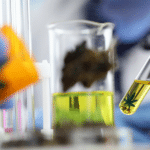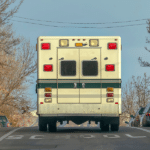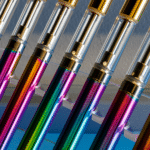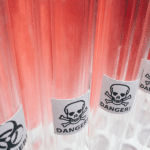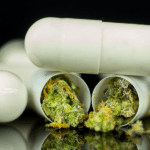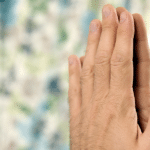“David,” a 10 year old boy, had his first seizure at 2 months of age. The convulsions were photosensitive generalized tonic-clonic seizures that occurred 1-4 times each day. These events were occurring daily, even though he was being treated with two anti-seizure medications – lamotrigine (Lamictal) and valproic acid. But they had already tried carbamazepine, phenobarbital, zonisamide and levetiracetam (Keppra) without success.
On the recommendation of his physician, THCA was added to his medication at 0.05mg/kg/day and his parents immediately noticed a reduction in seizure frequency. They then increased the THCA dosage to 2.2mg/kg/day, and even though there was no benefit noted to this increased dosage, the parents continued at this higher amount. After three months of THCA treatment, his parents reported to his physician a 40% reduction in seizure activity, shorter seizures, and the ability to discontinue the anti-seizure medication Diastat, which they had been using for seizure rescue. Hoping for even more control, they began a formula that contained THC at a THCA:THC ratio of 4:1. This caused transient side effects of somnolence but did nothing to improve the frequency of seizures.
Even if it did not completely resolve his seizure disorder, the phytocannabinoid THCA was able to make a significant difference in David’s quality of life. He is not alone. Cannabis holds hope for many, like David, who suffer from seizure disorders.
Epilepsy is a complex medical, economic, and social issue that affects at least 5.1 million of the US population by 2013 population reports. In Hawaii, there are an estimated 15,000 patients with seizure disorders. The total indirect and direct cost of epilepsy in the United States is estimated to be $15.5 billion yearly. 1, 2 For the individuals and families of those patients with seizure disorders, life can be limited and extremely complicated depending on the type and frequency of seizures and on the effects of anti-seizure medications, both therapeutic and undesirable.
Seizures occur when a part of the brain becomes overly excited or when nerves in the brain begin to fire in an abnormal way. An abrupt imbalance between the triggers of excitatory signals and inhibitory signals causes the excitatory forces to take over. This excitation then spreads to surrounding cells which all start firing in the same abnormal way. Increased excitation of nerve cells, or decreased inhibition of nerve cells due to a variety of potential insults can lead to a seizure. Balance, or homeostasis, is disrupted.
Most epileptics have no known cause for their seizures. The minority have numerous identified causes that include trauma, infections, inborn metabolic errors, drugs (or withdrawal from drugs), and inherited conditions.
Conventional Treatment
There are no treatments for the underlying causes of seizures, and no treatments to reliably prevent the development of seizures after head traumas. There are only medications to limit the seizure intensity or frequency, and these medications are not always effective. In fact, a third of epileptic patients fail to become seizure free even after trying and tolerating two or more appropriately prescribed anti-epileptic drugs (AEDs).3
More than 20 new seizure medications have been developed over the past few decades, but the percentage of patients with uncontrolled seizures has not changed as much as we would hope or expect. Patients who are resistant to AEDs have a higher risk of complications and sudden death due to epilepsy. The need for multiple AEDs also increases the occurrence of significant side effects. The need for better, safer, and more effective treatment is clear.
Safety Profile
Cannabis is a safe medication with no incidence of fatalities due to the lack of cannabinoid receptors in the brainstem. The most common side effects reported among patients using cannabis for seizure control are fatigue, decreased appetite, and somnolence, all of which resolve when cannabis is discontinued. AEDs can have significant side effects, and contrary to cannabis some of these can be fatal.
It is important to note that there are some drug-drug interactions when using cannabis with AEDs because cannabinoids are primarily metabolized by the Cytochrome P-450 system in the liver. Competition for these enzymes can affect the serum levels of AEDs, so patients using cannabis in addition to prescribed AEDs should be monitored, and dosage adjustments may be needed.
The Endocannabinoid System in Epilepsy
The job of the endocannabinoid system is to maintain homeostasis, so it is no surprise that cannabis has been used to help control seizures for centuries. Well-designed studies on rats have shown that the endocannabinoid system is a significant part of the brain’s response to seizure disorders.
We know that cannabinoid receptors are particularly dense in the central nervous system, and while we do not yet completely understand all the mechanisms that explain the anti-seizure effects of cannabis, we do have theories.
There are cannabinoid receptors in the hippocampus, that part of the brain that handles emotions and memory encoding. Abnormal changes in cells in the hippocampus are a cause of medial temporal lobe epilepsy, which is one of the most common forms. In this type of epilepsy, hippocampal cells create an excitatory feedback loop that causes seizures. Animal and human studies show that cannabinoids seem to be protective of the normal hippocampal cells, and may make the abnormal cells less active.4
In acutely seizing animals, the endocannabinoid 2-AG was significantly increased compared to controls. By testing the levels of both anandamide and 2-AG we have seen that both are synthesized on demand when seizures occur, thus activating the CB1 receptors. It also appears that there is a significant increase in CB1 receptor expression in epileptic animals, a receptor increase that is prolonged and probably permanent.
In studies done on rats with refractory seizures, it was noted that THC completely terminated those seizures without causing sedation, while maximal levels of phenobarbital or phenytoin were unable to do the same. This indicates that phytocannabinoids may offer advantages in treating refractory seizures compared to currently prescribed anti-convulsants.5
In more recent years research on animal models and human clinical observations have rekindled interest in using cannabis to control epilepsy. Cannabinoids decrease glutamate synthesis throughout the central nervous system, which in turn decreases inflammation and seizure activity.6 Regardless of the mechanism, human clinical observations are promising for the use of cannabis as an anti-epileptic medication, either alone or as adjunctive therapy.
Specific Cannabinoids as Medicine
The evidence continues to indicate that whole-plant usage is more effective than any single isolated constituent, perhaps due to the entourage effect. Cannabis contains many cannabinoids, THC and CBD being only two of over 80 possibles. In addition, the plant contains terpenes which are medically active chemicals that give the plant its fragrance. Combining these constituents can decrease side effects from any single cannabinoid and together, and may be more effective in controlling seizures. 7 We do not yet know what the best combination is for any specific type of seizure but the evidence is strong enough to encourage more research efforts for answers.
CBD: Is CBD the primary cannabinoid that treats seizure disorders? It seems so if you consider the recent reports of use in severely affected children. CBD is certainly a major player, but not the only one. CBD has been clinically proven as an anticonvulsant for many and at worst, for a minority of patients with epilepsy, it gave no benefit. Its anti-convulsive effects are probably due to a combination of beneficial activities. CBD blocks NMDA receptors (similar to the AED Felbamate) and enhances GABA receptors (similar to phenobarbital and Depakote). It stabilizes ion channels (similar to Dilantin and Keppra), acts as an anti-inflammatory, and also as a neuroprotectant.8
THC: In some study models, THC reduced seizure frequency and intensity, but in others there was no effect. Some patients treated with THC had increased seizure activity.6
THCA: THCA, the acidic raw form of THC is non-psychoactive and also appears to have anti-seizure qualities.9
CBDV: Cannabidivarin or CBDV, is a non-intoxicating cannabinoid that also has significant anti-convulsant properties which were even more effective when combined with CBD.6,10
Alpha-linalool: The terpene alpha-linalool has been shown to have anti-seizure activity in pre-clinical models, especially when combined with cannabinoids.7,9
Dosing
Cannabis has a biphasic dose-response, meaning that more is not always better or more effective. This is more prevalent in THC than in CBD but patients and clinicians are cautioned to avoid the assumption that if a dose is not working, it should be increased. It very well may need to be decreased, especially if THC is part of the preparation.
Dosing for adults has been noted at amounts as small as .02 mg cannabinoids/kg/day, but the clinical trials done on Epidiolex (a purified CBD product made by GW Pharmaceuticals) tested a range of 2-50mg/kg/day. While dosing cannabis for seizures is still an evolving science, an experienced physician treating children for intractable seizures shares the following guidelines. First, an EEG is recorded prior to starting CBD oil and then repeated at 1-3 months if the child is showing improvement. Oral or sublingual dosing of a quality-controlled, lab-analyzed CBD oil with a ratio of at least 10:1 CBD:THC is started at 1mg/kg/day divided into every 8 hour doses. These doses are increased every 1-2 weeks depending on the child’s results. She notes that the therapeutic range for many patients appears to be between 4-9 mg/kg/day. As the seizures decrease in frequency, it is possible that the AEDs can be slowly weaned.10
The latest publication on the use of cannabis for the treatment of epilepsy comes from three physicians with experience in the states of Maine, Washington, and California. Of their 272 combined patients, fourteen percent found cannabis to be ineffective at reducing seizures, fifteen percent experienced a 1-25% reduction in seizures, twenty-eight percent experienced a 76-99% reduction, and ten percent had a complete clinical response.
CBD Made the Difference
When Sam was 4, he had his first myoclonic seizure, and those progressed to myoclonic absence seizures. Sam did not fall to the floor and twitch. Instead, sometimes 100 times a day, he lost consciousness for 20-30 seconds at a time. He stopped, stared vacantly, his head bobbed rhythmically and then it would all be over. He didn’t even notice these seizures, only that when he would come to, everything around him had shifted slightly. But it kept him from a normal life: having full conversations, from learning in school, and from participating in sports.
Sam had tried almost two-dozen treatments including intravenous immunoglobulin and a ketogenic diet. Few of these were effective, and those that were either had worrisome side effects (hand tremors, hives, zombie consciousness, etc.) or they quit working after a short while. By the time he was 11, he was on massive doses of corticosteroids – the only thing they’d found that made any difference – but the side effects were devastating. He’d been hospitalized twice and seen six neurologists in three states.
Then, as a last resort, his parents decided to try CBD. The effects were profound, but the road was “not a straight line,” to quote his father. CBD had immediately helped – dropping the seizure rate from 68 on a Thursday to 6 on the following Monday. A few years after starting the CBD, Sam was down to between 0 and 5 seizures a day on 1000mg of CBD and taking no other seizure medications. Then, he had his first-ever generalized tonic-clonic seizure. Three weeks later he had another, so Depakote was added to his regimen. The Depakote worked.
Sam is now 15 years old and has had 15 months without a seizure. To his parents, this is a relief and a miracle. He is taking 875mg of Depakote a day, and 250mg of CBD twice a day. Now active in sports, fly fishing and rock climbing, Sam gets to be a normal boy.
Clearly, there is promise in the use of cannabis to manage epilepsy and still much to learn.
Stacey Kerr, M.D. is a teacher, physician, and author living and working in Northern California. Dr. Kerr was in private practice until she decided to write and educate full-time. This article was originally published by Hawaiian Ethos and may not be reproduced in any format without permission from the source.
References
- (cdc.gov/epilepsy)
- (http://www.epilepsy.com/hawaii)
- Kwan P. Brodie MJ. Early identification of refractory epilepsy. N Engl J Med 2000;342(5):314-9
- Gloss, Vickrey. Cannabinoids for Epilepsy. The Cochrane Library, 2012
- Wallace M.J. et al. The Endogenous Cannabinoid System Regulates Seizure Frequency and Duration in a Model of Temporal Lobe Epilepsy, Journal of Pharmacology and Experimental Therapeutics, Vol. 307:129–137, 2003
- Devinsky et al. Cannabidiol: Pharmacology and potential therapeutic role in epilepsy and other neuropsychiatric disorders. Epilepsia, 55(6):791–802, 2014
- Rosenberg EC, Tsien RW, Whalley BJ, Devinsky O. Cannabinoids and epilepsy. Neurotherapeutics. 2015;12:747–768
- Jones NA, et al. 2010. Cannabidiol displays anti-epileptiform and anti-seizure properties in vitro and in vivo. Journal of Pharmacology and Experimental Therapeutics 332(2):569-577
- Sulak D, et al. The current status of artisanal cannabis for the treatment of epilepsy in the United States, Epilepsy Behav (2017), http://dx.doi.org/10.1016/j.yebeh.2016.12.032
- Hill et al, Cannabidivarin is Anticonvulsant in Mouse and Rat, Br J Pharmacol. 2012 Dec;167(8):1629-42. doi: 10.1111/j.1476-5381.2012.02207.x.
- Elisabetsky E, Brum LS, Souza DO. Anticonvulsant properties of linalool in glutamate related seizure models. Phytomedicine 1999;6(2):107-13
- Bonnie Goldstein MD. https://www.theroc.us/goldstein.pdf


